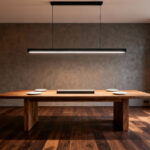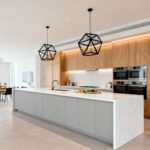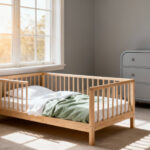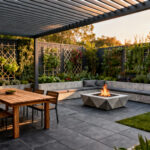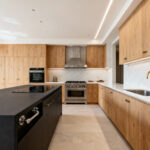Of all the design styles I work with, there’s something about a coastal kitchen that just settles my soul. I think it’s because, as a cook, I know the kitchen is a place of beautiful chaos. But when the light is just right and the colors feel like a soft ocean breeze, that chaos feels a lot more like a creative dance. It’s a space that encourages you to slow down, to chop your vegetables a little more deliberately, and to enjoy the process of nourishing the people you love.
The wonderful thing about this feeling is that it isn’t reserved for oceanfront mansions. A true coastal kitchen isn’t about plastering anchors and fishnets everywhere—it’s about capturing a state of mind. It’s about building a serene, bright, and functional heart of your home, whether you can smell the salt air from your window or you’re hundreds of miles inland. Ready to bring that easy, breezy feeling into your own home? Let’s walk through how to do it.
1. Start with a Foundation of Sand and Sky
Every great dish starts with quality base ingredients, and a kitchen is no different. The foundation of a successful coastal kitchen mimics that moment on the beach where the sand meets the horizon. We’re talking about a palette built on crisp whites and warm, sandy beiges. These aren’t just colors; they are light-magnifiers. They take whatever natural light you have and bounce it around the room, instantly making the space feel more open and alive. But—and this is important—it’s not about just slapping on one shade of white. Layering different tones and sheens is what gives the room depth and stops it from feeling cold or sterile.

I’ve found that the real magic happens in the texture. Think matte walls, the soft gloss of a simple tile, the grain of a light wood, and the weave of a basket all living together in that neutral palette. On a recent project for a family whose cottage was their year-round home, we used Sherwin-Williams’ Pure White on the shaker cabinets and painted the island in Benjamin Moore’s Revere Pewter, which has this wonderful warm greige tone. It felt grounded and airy all at once. The moment the morning sun hit it, you just wanted to pull up a stool with a cup of coffee.
This clean, bright canvas is what lets you start painting with the true colors of the coast.
2. Weave in the Emotion of Ocean Blue
Once your foundation is set, this is where the personality really starts to emerge. To me, blue isn’t just a color; it’s an emotion. Think about it: from the deep, grounding navy of the open ocean to the hopeful pale blue of a clear morning sky, each shade tells a story. And you get to decide which story you want your kitchen to tell. The key is to use it strategically, not just splash it everywhere. Where do you want to draw the eye?

A kitchen island is the perfect candidate. Painting the base in a rich, dramatic navy—like Sherwin-Williams’ Naval—instantly creates an anchor for the entire room. It says, “This is the gathering spot.” I remember one renovation where we did just that, and it immediately became the star. Another, more subtle trick I love is to paint the inside of cabinets a soft sky blue. It’s this delightful little surprise every time you open a door to grab a plate. It’s a quiet detail that makes the space feel custom and thoughtfully designed.
But deep blues, as beautiful as they are, aren’t the only option. There’s another side to the ocean’s palette that whispers instead of shouts.
3. Add the Soothing Whisper of Seafoam Green or Aqua
This is the color of sea glass, of the shallow water that laps at the shore. Seafoam green and its cousin, aqua, are where blue and green meet in perfect harmony. These shades don’t just add color; they add a sense of calm. There’s a psychological reason we’re drawn to them—they’re nature’s neutrals, and they signal tranquility to our brains. What I love most is how these hues play with light. They can look soft and muted in the morning and then become surprisingly vibrant in the afternoon sun.

A small galley kitchen I worked on felt dark and cramped, a common frustration for many homeowners. We kept the cabinets white but installed a backsplash of glossy aqua subway tile from floor to ceiling on the main wall. It completely transformed the room. The tile caught and bounced what little natural light there was, making the space feel twice as big and a hundred times more cheerful. If you’re considering these colors, be sure to get samples and look at them at different times of the day in your own kitchen. It’s the only way to know how they’ll truly live in your space.
Now that we have our color story, let’s talk about adding character with texture and architectural details.
4. Bring in Coastal Character with Shiplap
There’s a reason shiplap has become so deeply associated with coastal and farmhouse design. Its origins are literally maritime—it was first used to create a watertight seal on the hulls of ships. Bringing it into the kitchen adds more than just texture; it brings a story. The clean, horizontal lines have this wonderful, rhythmic quality that feels both casual and incredibly stylish. It’s instant architecture.

Painting it a crisp white is the classic choice, and for good reason. It makes the subtle shadow lines pop, adding visual interest without making the room feel busy. But you don’t have to limit it to an accent wall. Wrapping your kitchen island in shiplap is one of my favorite ways to add character. I worked with one client on a tight budget who transformed their boring, flat-sided island using inexpensive MDF shiplap panels from a home improvement store. They painted it white, and for under $200 and a weekend of work, they had a stunning new focal point. It was a total game-changer for their kitchen.
There’s another paneling style that offers a similar cottage vibe but with a slightly more refined texture.
5. Get that Cottage Feel with Beadboard Panels
Where shiplap is defined by its rustic horizontal lines, beadboard is all about delicate, vertical grooves. If shiplap feels like a sturdy fishing boat, beadboard feels more like a charming seaside cottage. The way its narrow raised beads catch the light is just beautiful, and it can add a ton of personality to flat, uninspired surfaces. Frankly, it’s one of the best ways to get a high-end, custom look without the high-end cost of new cabinetry.

One of the most dramatic transformations I’ve ever seen involved a kitchen with dark, dated oak cabinets. The homeowners couldn’t afford a full replacement. So, we painted the cabinet boxes white and added custom-cut beadboard panels to the recessed center of each door before painting those to match. The difference was staggering. The dark, heavy kitchen became bright and full of charming texture. A quick tip: If you’re using it in a kitchen, look for moisture-resistant MDF or PVC beadboard, especially if you’re using it as a backsplash. It holds up beautifully to the realities of a working kitchen.
Beyond the walls and cabinets, your work surfaces are a golden opportunity to introduce a different kind of natural element.
6. Warm Things Up with Lightly Stained Wood Countertops
In a world of cool blues, crisp whites, and hard stones, a kitchen can start to feel a little…chilly. This is where the warmth of wood comes in. A lightly stained wood countertop, especially on an island, feels like bringing a piece of sun-bleached driftwood right into your home. It’s an organic touch that provides a beautiful, necessary contrast to the cooler coastal colors. From a cook’s perspective, there’s nothing quite like the feel of a wood surface—it’s forgiving, it’s warm, and it feels alive.

Wood countertops have a character that manufactured materials just can’t replicate. Each piece has a unique grain, and they develop a lovely patina over time that tells the story of the meals prepared there. For a waterfront home, we used reclaimed white oak for the island countertop and finished it with a clear, matte tung oil. It was sophisticated but felt completely unpretentious. And yes, wood requires a bit more care than quartz. But for those who love the look and feel, sealing it properly with a food-safe or marine-grade finish makes all the difference in its longevity.
The surface beneath your feet is just as important for setting that bright, airy tone.
7. Build on a Foundation of Light Wood Flooring
Have you ever walked into a room and instantly felt it was bigger and brighter, even before you knew why? Chances are, the flooring had a lot to do with it. Dark floors can be beautiful, but in a coastal kitchen, they absorb light. Light oak or white-washed wood floors do the opposite—they act like a reflector, bouncing light up and making the entire space feel more expansive and cheerful. It’s like laying down your own strip of sandy shoreline.

I’m a huge fan of wide-plank, white-washed oak. We used it in a coastal bungalow renovation, and it not only looked incredible but also proved tough enough to handle two kids and a dog. The light color created a seamless flow from the kitchen into the dining area and provided the perfect neutral backdrop that made every other design choice pop. A word of advice: always bring floor samples home. What looks one way under the harsh lights of a showroom can look completely different in the soft morning light of your kitchen.
Now, let’s look up. How we handle storage can dramatically change the feeling of openness in the room.
8. Create an Open, Airy Vibe with Open Shelving
I know, I know. The minute I say “open shelving,” some people get nervous. Dust! Clutter! Stay with me here. Replacing some, not necessarily all, of your bulky upper cabinets with simple, streamlined shelves is one of the most effective ways to make a kitchen feel larger. It reduces the visual weight at eye level, creating that breezy atmosphere that’s so key to the coastal aesthetic. The impact is immediate and undeniable.

This isn’t about displaying your mismatched Tupperware. This is curated storage. I worked with a client in a tiny galley kitchen who was brave enough to take down all the upper cabinets on one wall. We installed two long, thick floating shelves and stocked them with her everyday white dishes and some blue-patterned accent bowls. The room instantly felt more spacious and inviting. The trick is to only display things you use regularly (so they’re always being washed) and things you truly love to look at.
But what about the things you want to display but also protect?
9. Showcase Treasures in Glass-Front Cabinets
Glass-front cabinets are the perfect middle ground between closed-off upper cabinets and fully open shelving. They give you that same sense of lightness and allow you to break up a long run of solid wood doors, but they keep your treasured items safe from dust and cooking splatters. This is where you can let your personality really shine. It’s the perfect spot to display collections that tell your family’s story.

I once worked with a family who had collected shells, coral, and sea glass from their beach vacations for years. We designed their island with back-lit, glass-front cabinets on the side facing the living room, specifically to display these treasures. In the evening, when they turn on the soft interior lights, it transforms their collection into a stunning piece of art. It’s a beautiful, personal touch that makes their kitchen uniquely theirs.
Even the smallest details can have a surprisingly huge impact on the final look.
10. Add Authentic Texture with Rope or Nautical Hardware
This is one of my favorite little secrets for taking a kitchen from “nice” to “wow.” Standard cabinet pulls are fine, but swapping them for something with authentic texture can completely change the feel of your cabinetry. Rope or jute-wrapped pulls, or even simple pulls shaped like a nautical cleat, immediately connect the space to maritime tradition. It’s a tactile detail—you can literally feel the texture—that makes your kitchen feel more grounded and interesting.

I find these work especially well on drawers and lower cabinets, where you can see and touch them up close. One homeowner with perfectly fine but generic builder-grade white cabinets wanted a coastal update on a shoestring budget. We did nothing but swap out the boring metal knobs for some chunky, natural jute rope knot pulls we found online. For a couple of hundred dollars, the whole kitchen suddenly had character and a distinct point of view.
Of course, if rope isn’t your style, the finish of your metal hardware is just as important.
11. Choose the Right “Jewelry” with Brass or Nickel Hardware
I always tell my clients that cabinet hardware is the jewelry of the kitchen. It’s the finishing touch that can pull the entire look together. For a coastal design, there are two finishes that I find work beautifully time and time again. Polished brass has this warm, almost golden glow that feels wonderfully nostalgic, like the fixtures on a vintage sailboat. It pairs gorgeously with navy blues and crisp whites. On the other hand, brushed nickel offers a cooler, softer sophistication that blends seamlessly with stainless steel appliances.

In a kitchen we designed with classic white shaker cabinets and soft blue-gray walls, the original hardware was a dated, shiny chrome. We replaced them all with polished brass cup pulls on the drawers and simple knobs on the doors. The warmth of the brass against the cool tones was just stunning. It instantly elevated the space, giving it a timeless, nautical charm. It’s a small change that delivers a massive visual return.
Now for one of the biggest opportunities to make a statement: the backsplash.
12. Keep it Clean and Timeless with Classic White Subway Tile
There’s a reason this humble 3×6-inch tile is an icon. It’s simple, it’s clean, and it reflects a ton of light—three things that are absolutely essential for a coastal kitchen. It provides a quiet, uncluttered backdrop that lets other elements, like your colored island or beautiful countertops, take center stage. You just can’t go wrong with it. Its versatility means it works just as well in a modern coastal kitchen as it does in a traditional cottage setting.

My pro tip? Don’t just stop at the standard height. Take that tile all the way up to the ceiling, especially behind the range or on a wall with open shelving. This creates a really powerful, seamless look that draws the eye upward and makes the room feel taller. We did this on the entire sink wall in a small cottage kitchen, and the bright, reflective surface made the whole space feel so much more expansive and finished.
If you’re looking for a backsplash that’s a bit more of a showstopper, there’s another option that truly captures the magic of the sea.
13. Capture the Light with Iridescent Glass Tile
If classic subway tile is the quiet, sandy shore, then iridescent glass tile is the sunlight sparkling on the water. This is a material with life in it. The tiles are coated with a metallic oxide that refracts light, creating subtle shifts in color as you move around the room or as the light changes throughout the day. It’s not a static surface; it’s dynamic and beautiful, and it brings a touch of magic into the kitchen.

A kitchen I designed featured small, one-inch square mosaic tiles in a mix of pale blues and seafoam greens with an iridescent finish. The final backsplash genuinely looked like dappled sunlight on shallow water. It was mesmerizing. Now, a word of caution: a little of this goes a long way. Because it’s such a statement, it’s best to pair an iridescent backsplash with simpler, matte finishes on your countertops and cabinets. You want to let it be the star of the show.
Let’s move on to those hard-working horizontal surfaces.
14. Choose Bright and Durable quartz countertops
From a culinary perspective, your countertop is your primary stage. It needs to be tough. For a coastal kitchen, you also want it to be bright. This is why light-colored quartz is so often my top recommendation. It gives you the clean, bright look of marble or other natural stones but without the headaches. Because it’s non-porous, you don’t have to worry about that splash of red wine or lemon juice staining it, and it never needs to be sealed.

We recently swapped out dark, dreary laminate countertops in a client’s home for a bright white quartz with very subtle, soft gray veining. The kitchen instantly felt 10 years younger and twice as bright. The quartz bounced the light from the window across the room, creating an energy the space never had before. As with flooring, make sure you look at large samples in your own home’s light before you commit. The tiny two-inch squares at the store just don’t tell the whole story.
For those who lean toward a more modern, organic beach vibe, there’s another great option.
15. Get a Modern Beach Vibe with Concrete Countertops
At first, concrete might sound industrial and cold, but hear me out. When pigmented in a light gray or even a soft white and honed to a smooth finish, concrete has an earthy, organic quality that feels incredibly sophisticated. It’s the perfect blend of modern lines and natural material, like a smooth, water-worn stone you’d find on the beach. What’s truly amazing is its customizability. You can have a sink integrated right into it, or even embed recycled glass or small, subtle shells for a one-of-a-kind look.

I worked on a modern beach house that featured light gray, polished concrete countertops with a waterfall edge on the island. The cool, smooth surface was a beautiful contrast to the warm wood floors and woven barstools. It was minimalist but still felt connected to nature. It’s a bold choice, but for the right home, it can be absolutely stunning. Plus, as a cook, I love that you can set a hot pan directly on it without a second thought.
Now, let’s illuminate all these beautiful choices.
16. Set the Mood with Glass or Woven Pendant Lights
Lighting is everything. It sets the mood, provides crucial task lighting for chopping and cooking, and serves as a major design element. Over an island or peninsula, pendant lights are a must. For a coastal kitchen, I lean toward two main styles: clear glass or natural woven materials. Glass pendants, whether in a globe or lantern shape, are fantastic because they don’t obstruct the view. They add sparkle and light without creating visual clutter, which helps maintain that open, airy feeling.

Woven shades made from materials like rattan, jute, or seagrass introduce that critical element of natural texture. They contrast beautifully with the smooth, hard surfaces of the kitchen and cast a warm, inviting glow. Imagine three large, clear glass globes over a long island for a clean look, or a single, oversized woven pendant for a more relaxed, bohemian feel. And please, whatever you choose, put them on a dimmer switch! This is my number one rule for kitchen lighting. It allows you to go from bright, functional light for prep work to a soft, ambient glow for dinner parties.
Of course, the best light source is the one that’s free.
17. Maximize Every Ounce of Natural Light
Before you spend a dollar on a light fixture, look at your natural light sources. This is the single most important element in any coastal design. It’s what makes the whites look brilliant, the blues vibrant, and the entire space feel cheerful and expansive. Are your windows blocked by heavy curtains? Can you add a window, a skylight, or even a solar tube? Any investment you make in maximizing sunlight will pay you back tenfold in daily enjoyment.

A few years ago, we worked on a galley kitchen that had one small window and felt like a cave. By simply adding a larger picture window over the sink and installing two solar tubes in the ceiling, we completely changed its DNA. The space was suddenly flooded with beautiful, natural light all day long. The clients said it changed not just their kitchen, but how they felt starting their day. If major changes aren’t possible, even a simple trick like hanging a large mirror on a wall opposite a window can help bounce light deeper into the room.
The right seating can add the final layer of comfort and texture.
18. Pull Up a Woven Rattan or Seagrass Stool
Your kitchen island is a magnet for gathering, so the stools you choose are more than just a place to sit; they’re a key part of your design. This is a perfect place to inject that natural, organic texture we’ve been talking about. Woven rattan or seagrass stools provide a wonderful contrast to a smooth stone or concrete countertop. They signal a casual, relaxed vibe and stop the kitchen from feeling too precious or formal.

Picture classic counter-height rattan stools with low backs pulled up to a navy blue island. The warmth and texture of the stools immediately balance the cool, solid color of the island base. They just invite you to sit down and stay awhile. For practicality—because kitchens are messy!—look for styles that have removable cushions with washable covers. A simple striped linen or a durable outdoor fabric in a coordinating color is both comfortable and easy to clean.
Don’t forget the walls! Meaningful art can make the space feel truly personal.
19. Personalize Your Walls with Beach-Themed Art
Empty walls can make a kitchen feel unfinished. But what you hang should feel personal, not like you bought it from the “coastal decor” aisle at a big box store. This is your chance to hang pieces that evoke a memory or a feeling. It could be a large-format photograph of your favorite beach at sunset, a simple watercolor of waves, or a collection of smaller prints. The key is to choose art that complements your color palette instead of clashing with it.

I always remember a client’s kitchen where we hung a huge, moody photo of an empty lifeguard stand over the dining nook. The warm, golden tones in the sunset photo were the perfect counterpoint to the kitchen’s cool whites and blues. It became an instant conversation piece. Just remember the practicalities: kitchens produce heat and moisture, so hang valuable pieces away from the main cooking zone and consider using protective glass or acrylic.
Why hang a picture of the beach when you can bring a piece of it inside?
20. Decorate with Authentic Natural Elements
This is what separates a truly authentic coastal kitchen from a themed one. A few thoughtfully placed, ethically sourced natural treasures can ground your entire design in reality. A beautifully sculptural piece of driftwood, a large conch shell, or a simple bowl filled with sea glass has a texture and form that manufactured decor simply can’t match. These are the details that give a kitchen its soul.

I love placing a single, dramatic piece of driftwood on top of the cabinets or on a high shelf. It creates a stunning focal point. For smaller items, try grouping them in odd numbers, which is always more visually appealing. A cluster of three large shells on a floating shelf, or five pieces of smooth beach stone on a windowsill. Just be sure to give them a good cleaning before bringing them inside. This is your personal collection, and it makes the space feel truly one-of-a-kind.
Let’s not forget the floor. Softness underfoot is a welcome addition to any kitchen.
21. Layer in Color and Comfort with Striped Rugs
Kitchens are full of hard surfaces—cabinets, counters, appliances, floors. That’s why adding soft textiles is so important for creating a balanced, comfortable space. A striped runner or a set of striped cushions is a classic for a reason. It’s a nod to nautical style that feels timeless and fresh. Placing a runner in front of the sink or main prep area is a gift to your feet and back during long cooking sessions, trust me.

This is where you need to be practical. Look for rugs made from durable, easy-to-clean materials like jute, polypropylene, or other indoor/outdoor fabrics. These are designed to handle high traffic and spills, which are inevitable in a kitchen. You can get that great coastal look—a classic navy and white or a softer jute and cream stripe—in a material that’s built to last. It’s the perfect marriage of style and function.
The biggest workhorses in the room—your appliances—also play a huge role in the design.
22. Choose Your Finish: Matte White or Stainless Steel
Appliance finishes can either enhance your coastal design or fight against it. The two best choices, in my experience, are matte white and classic stainless steel. Matte white appliances have become incredibly popular, and they are perfect for a coastal kitchen. They blend almost seamlessly with white or light-colored cabinetry, which makes the whole space feel larger, calmer, and less visually cluttered. They let the architectural details and textures be the star.

I designed one kitchen with matte white appliances set against a white shiplap wall, and the appliances nearly disappeared. The effect was incredibly serene. Classic stainless steel is also a great choice. It has a clean, professional look that works well, and its reflective surface helps bounce light around the room. For a cohesive, high-end look, try to coordinate the finish of your appliance handles with your cabinet hardware—it’s a small detail that makes a big difference.
No kitchen is complete without its most crucial fixture.
23. Anchor the Space with a Classic Farmhouse Sink
From both a functional and an aesthetic standpoint, the sink is the heart of the kitchen work zone. A big, beautiful farmhouse sink, also known as an apron-front sink, is practically tailor-made for a coastal kitchen. Its generous, deep basin is a cook’s dream—you can easily wash a giant stockpot, a bushel of greens, or even a small dog if you wanted to! The exposed front panel also acts as a stunning architectural feature, anchoring the sink area as a clear focal point.

In a family beach house, we installed a massive single-bowl white fireclay sink in the island. It became the command center for everything from prepping veggies for a crowd to hiding the dirty dishes during a party. Its substantial presence was the perfect balance to the large scale of the island. Fireclay is the classic choice for its beauty and durability, but a stainless steel apron-front sink can give a more modern, yet equally functional, coastal vibe.
Finally, bring your kitchen to life with a touch of green.
24. Breathe Life into Corners with Coastal-Friendly Plants
Plants are the final touch that make any room feel complete. In a kitchen, they not only add vibrant color and natural texture but can even improve air quality. A few well-placed, easy-care plants can transform a dead corner or a bare shelf into a little pocket of life. You want to choose plants that are tolerant of the humidity and temperature shifts common in kitchens.

My go-to plants for this are nearly indestructible: snake plants, pothos, and succulents. A tall snake plant in a woven basket is perfect for adding height in a forgotten corner. A trailing pothos on top of the cabinets adds a lovely cascade of green. They don’t just look good; they fit the low-key, easy-living vibe of coastal design because they require so little from you. And don’t forget a pot of herbs on the windowsill—like rosemary or basil—for fragrance, beauty, and of course, easy access while you cook.
A Kitchen That Feels Like a Deep Breath
Putting together your dream coastal kitchen isn’t about checking items off a list. It’s about thoughtfully layering these different elements—color, texture, light, and personal touches—to create a space that feels like a refuge. It’s about building a room that not only functions beautifully for all your cooking and entertaining needs but also nurtures your spirit.
The real magic happens in those small moments: the way the morning light catches an iridescent tile, the warm feel of a wood countertop under your hands, the satisfaction of snipping fresh herbs from your windowsill. This is how your kitchen transforms from just a room in your house into a daily retreat—a place where the stresses of the world seem to fade away, replaced by a deep and abiding sense of calm.

